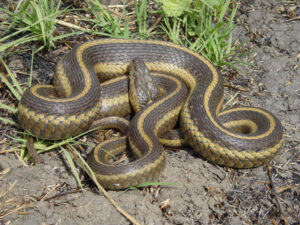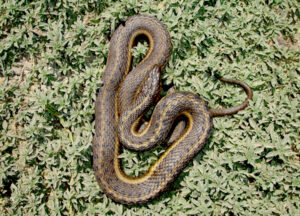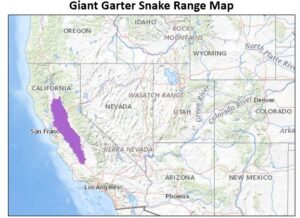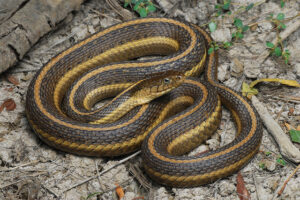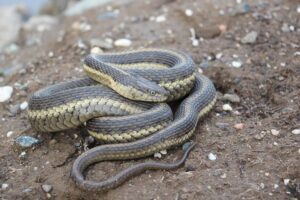The giant garter snake is the biggest of all species of garter snakes. The semi-aquatic snake is relatively rare. They are diurnal from spring to late fall and overwinter on land before coming out the following spring. It is active when water temperatures are at 68°F (20°C) or more and remains dormant underground when its aquatic habitat is below this temperature.
Scientific Classifications
- Suborder:Serpentes
- Family:Colubridae
- Genus:Thamnophis
- Species:T. gigas
Conservation Status
Description
Size
The adults reach a length of 37-65 in (94-165 cm). The females are larger than the males.
Color and Appearance
The body has a black or dark grey ground color with a yellow dorsal stripe. There are two additional stripes running along the length of either side of the body. But some individuals can have unstriped checkered patterns. The serpent has keeled scales.
Are They Dangerous to Humans
Though venomous, the giant garter snake is harmless to humans. The mild, neurotoxic venom is used to subdue its prey. In humans, the bite can, at the most, cause a red itchy rash around the bitten area. If threatened or disturbed, it releases a foul-smelling musk from its cloaca.
Giant Garter Snakes at a Glance
Distribution
This garter snake has a limited range in the central California wetlands of the United States. The distribution mainly includes the Sacramento and San Joaquin Valleys of the state.
Habitat
It predominantly inhabits artificial wetlands associated with rice cultivation. It lives in rice field canals and agricultural rice wetlands. It is rarely found more than a few meters away from water in its active season. The snake prefers slow-moving or stagnant water bodies with emergent vegetation.
Despite their preference for water, they spend most of their lives on land, underground. When not underground, they seek vegetation (mainly tules) or litter to keep them protected from extreme weather and predators. They avoid rocky or otherwise open areas.
Lifespan
Their lifespan in the wild is unknown.
Predators
The colubrid has several natural predators. The young snakes fall prey to California kingsnakes and American bullfrogs. The adults get eaten by various raptor birds. They have evolved a fast diving technique to avoid their predators.
Diet
Their predominantly aquatic lifestyle makes them prey upon frogs, fish, and tadpoles. Historically, local species like the Sierran treefrog would form its diet, but currently, they feed mostly on introduced species like the American bullfrog.
The snake has increased levels of heavy metals like mercury in its bloodstream as it eats mercury-rich fish, but further research is needed to ascertain if that has any detrimental effects on the snake’s health.
Reproduction
Ovoviviparous (gives birth to live young from eggs that hatch inside the body)
The males start searching for a mate after emerging from hibernation. As their hibernation dens are typically more spread out than other garter snakes, the males must spend more energy finding a female to mate with. This results in a decrease in their body condition forgoing feeding and growth. On the other hand, females have an increased body condition at around the same time, presumably for supporting embryo development. The gravid females also bask more often than non-gravid females and males, which is thought to facilitate embryo growth.
After mating in spring, they give birth from mid-July to early October. The average litter consists of 17 young. The larger females produce more babies compared to the smaller ones rather than producing fewer and larger offspring. The baby’s size also heavily depends on the availability of resources in the year.
FAQs
Ans. Widespread habitat loss coupled with wetland destruction has made it an endangered species. Their populations in the San Joaquin Valley are now tiny disjointed remnants. They have been wiped off from 98% of their erstwhile San Joaquin habitat. They have fared better in the Sacramento Valley as rice agriculture, and the associated canals have provided them suitable habitat with water, food, and cover. Fallowing of rice land makes them move away from adjacent ditches.
Plus, their dependence on water has prevented them from effectively dispersing to new habitats. This has led to a fragmentation of their population as the areas between their habitats are not hospitable to it.
Additionally, introduced predators like the northern water snake and American bullfrog challenge their survival. Recovery plans are underway to reinstate artificial wetlands to provide the snake with quality habitat. But it is too early to know whether these efforts will help recover the threatened species.
Ans. Though the exact number is unknown, there are only 13 isolated populations of the species living primarily in the Sacramento Valley.
Source
dfgnews.wordpress.com, csp-inc.org, birdwatchinghq.com, rivergardenfarms.com, snakesarelong.blogspot.com, duazurecdn.azureedge.net

